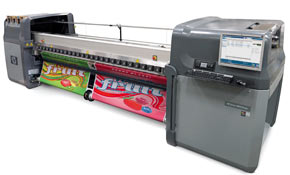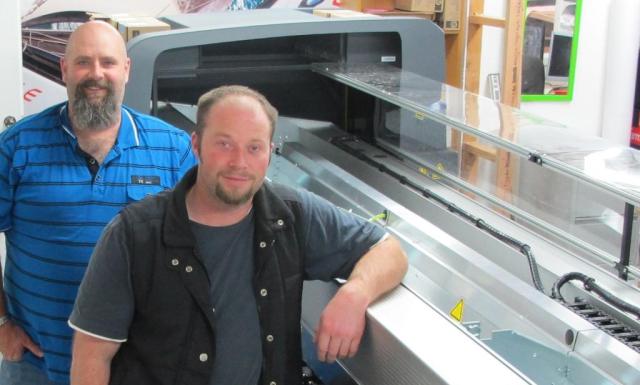
The 3.2m-wide, roll-to-roll LX800 is the third generation to use latex, pushing it up further into the industrial space and challenging solvent and UV-cured machines. The first latex unit, the 2.6m-wide, roll-to-roll Designjet L65500 sat in a slightly curious sector of the market, a bit too big to challenge the eco-solvent brigade and a bit too small to tackle hard solvent and UV-cured heavyweights.
So having launched the Designjet L25500 last year to tackle the eco solvent sector, this year HP beefed up the latex line, replacing the L65500 with the LX800 and its sister the LX600, a 2.6m-wide device that is its direct replacement. Both highlight their production credentials with a Scitex label rather than the Designjet moniker.
As befits an industrial device with a $325,000 price tag, the LX800 includes a dual roll kit to allow two-up production to make the most of its productivity and a mesh printing kit for fabric printing. Despite tidying up the marketing and positioning, the LX800 is still tricky to pigeonhole, but in a good way. David Booth, general manager of CPI Graphics, says this is because it is so versatile.
“It is ideal for any flexible materials, so is very good for self-adhesive vinyls, paper, backlit film and canvas. We have even run mesh and heavyweight materials such as flag-type substrates and it has performed exceptionally well on those.”
Just as its media handling capabilities are broad, so too is the machine aimed at a wide range of applications, says Booth. “Everything from real estate signs to point-of-purchase to general banners, sporting banners, light boxes, bus shelters, street furniture – anywhere that high-quality print output is required.”
Booth says the LX800 is a better bet than rivals for 80% of typical wide-format work, but cedes it doesn’t suit some applications. It won’t produce five-metre billboard work. Nor will it handle rigid media and there are some materials the LX800 can’t cope with – raw cotton, silk and lightweight polypropylene. In these cases, Booth says a dye-sublimation machine would be a better fit.
Winning combination
But there are also a number of other reasons that this machine beats out the competition, says Booth.
“It is odourless and work comes off the printer dry and ready for finishing. You can laminate it straight away – just cut it off the machine and send it off for lamination. You can’t do that with solvent or UV-cured inks. Latex has a huge advantage there. Because it comes off dry, it can be stacked and ready to send out. You don’t need to treat it with kid gloves.”
He points out some of the downsides to rival technologies. “If you look closely at UV-printed output, you can see UV banding. It is just the way UV dries.”
HP claims odourless latex inks also open up new possibilities where the smell of solvent or UV print restricts their use.
“One of the things HP has been pushing with latex ink is interior decorating and architectural design. You can print on wallpapers. You could print on the substrate, hang it in a restaurant, and diners could eat their meal right
next to it without them noticing.”
He gives the example of a client in Western Australia who designed a children’s hospital ward. “They printed cartoon characters on clear vinyl and all that was done with latex inks. One reason is because it is environmentally friendly, non-toxic and doesn’t smell.”
As is to be expected in the face of a disruptive technology, rivals have rubbished HP’s claims for latex. Their arguments include that the inks do contain solvents, that despite HP’s green messaging the machine has high energy consumption due to the heaters used in the two-stage drying and curing process, and that ink consumption is much higher, and so costs go up too.
Booth admits he has heard the comments about ink and power usage.
He counters this by saying: “We have found that ink consumption on the machine has been excellent, when you take into account the whole print cycle in comparison to solvent. Solvent printers don’t use as much ink but every hour they have to flush their heads, wasting ink. The latex machine doesn’t do that. The ink consumption might be marginally higher but they don’t have the wasted ink.
“In terms of power consumption, when you compare it to some of the solvent machines that have heaters or post-print dryers then the cost in terms of energy is similar or even in favour of the latex printer. If you take total cost of power consumption, it works out to 1.5c per m2 – is that huge amount to get worried about?
Booth adds: “There are other areas you can save more money, such as quicker turn-arounds, quicker finishing and higher quality.”
Based on CPI Graphics’ demo unit, he says average consumption over months of sample printing is 12ml/m2. This compares to 8-10ml/m2 for eco solvent and 10-11ml/m2 for a UV-cured. The cost of ink at recommended retail prices under HP’s volume user programme is $130 per litre, giving an ink cost of $1.56/m2 and including printheads and head cleaning roll the price works out at $1.95/m2.
HP states power consumption of 8kW to 15kW during printing. “Typically competitors do not supply any information or give it in kVA [kilovolt-ampere], which you cannot easily convert into kWh. We are confident that the LX800 has a power consumption level similar to its rivals.”
Booth says: “We use about 17c/kWh in Australia, so it costs $2.55 running at 45m2, which works out at so 5.7c/m2.”
“Even if a competitor is 25% lower on power consumption, it is only 1.5c/m2 difference. If this is the main argument against latex they need to find another.”
They claim to have one: the solvent issue. If you want to be a pedant then in water-based (aqueous) inks there is a solvent – water. HP’s argument is that in its (and other’s) water-based inks there are also co-solvents – glycols and alcohols that optimise the wetting and jetting of the ink – and they typically make up around 30% by volume. Latex inks are similar to water-based inks, but also include the thermo-polymer that fuses onto the substrate to form a tough ink film. Being similar to the ink used in its other Designjet machines means the latex-based products, even industrial ones like the LX800, deliver similar resolution, density and image quality.
You might think that the penalty of high quality was low speed, but having shoe-horned in 31,680 nozzles – over 15 times the count of some rivals – HP claims the machine is fast, and in some applications, particularly where high quality is needed, faster than rivals.
The LX800 can produce good quality banners at 90m2/h, high-quality POP work at 45m2/h and backlit can be produced at 27m2/h without a drop in density or quality. That high nozzle density comes courtesy of HP’s scalable printing technology. HP is confident about the robustness; it is also deployed in its high-volume web presses.
Heads are user replaceable and Booth says you can be back in production in 15 minutes. Servicing is also claimed to be a cinch, and it is also self-maintaining. There is no daily maintenance procedure and it has automatic nozzle replacement for reliable overnight printing, built-in spectrophotometer for automatic recalibration and automatic alignment and head calibration.
There are around 15 units in Australia and New Zealand between the 2.6m and 3.2m versions, and after two years in the market it is proven technology. HP initially promoted latex for its enviro-nmental credentials, however, it now also argues for its cold commercial logic.
SPECIFICATIONS
Format
3.2m roll-to-roll
Speed
88m2/hr
Resolution
1,200dpi
Colours
CMYK, light cyan, light magenta
Technology
HP latex inks using thermal scalable printing technology
Price
$325,000
Contact
CPI (03) 9263 9800
Celmac (03) 9380 7111
GBC Australia 1800 422 349
THE ALTERNATIVES
Agfa Jeti 3348 UV Galaxy RTR
Agfa’s Jeti offers similar price/performance to the LX800 using UV inks delivered via 48 Spectra printheads. It includes a dual roll option along with a camera for registering front and back images for backlit quality.
Width – 3.2m
Speed – 80m2/hr
Resolution – 600dpi
Colours – CMYK, light cyan, light magenta
Price – $325,000
Contact Agfa – (03) 9756 4220 steve.taylor@agfa.com
Durst Rho 320R
Durst says the Rho 320R’s quality made it the first industrial machine to be capable of close-view quality for applications such as lightboxes and POP. Boasts strong green credentials with the Rho Roll VOC-free inks the first to be awarded Nordic Swan accreditation.
Width – 3.2m
Speed – 130m2/hour
Resolution – 600dpi
Colours – CMYK standard, optional: light cyan and light magenta, white, varnish, and spot colours
Price – €279,000
Contact Photo Electronic Services (03) 9374 2700
www.photoelectronics.com.au
EFI Vutek QS3250r
Thanks to a water-cooled platen, the QS3250r can print onto heat-sensitive materials like thin, cheap vinyls, while the UV inks are claimed to be very flexible, so suitable for applications such as fleet graphics.
Width – 3.2m
Speed – 172m2/hr in ‘fast four’ mode;
83m2/hr in eight-colour mode
Resolution – 540dpi/1,80dpi
Colours – CMYK, light cyan, light magenta, light yellow and light black, or 2xCMYK
Contact DES – 1300 728 411 or iMedia 1300 132 644
Fujifilm Uvistar
Based on Israeli firm Matan’s chassis with Sericol Uvijet inks, the Uvistar takes Fujifilm’s extensive UV experience into the high-speed roll-to-roll sector. Uvijet QK inks enable thin and flexible substrates including polyethy-lene, self-adhesive vinyl, PVC and textiles to be handled for bulk rolls of low-cost materials. Available in 16 and 32 head configurations to suit different requirements.
Width 3.5m
Speed UVR 3532: 260m2/hr, UVR 3516: 148m2/hr
Resolution 600dpi
Colours CMYK
Price UVR 3532: $395,000 UVR 3516: $465,000
Contact Michael Liveris 0419 770 622, michael.liveris@fujifilm.com.au
Comment below to have your say on this story.
If you have a news story or tip-off, get in touch at editorial@sprinter.com.au.
Sign up to the Sprinter newsletter


